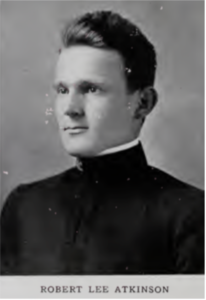Scroll of Honor – Robert Lee Atkinson
Pandemic
Written by: Kelly Durham
COVID-19 is not the first pandemic to make an appearance on the Clemson campus. Just over a hundred years ago, the Spanish  Flu spread to the small college in the South Carolina Foothills with a far more deadly effect.
Flu spread to the small college in the South Carolina Foothills with a far more deadly effect.
Robert Lee Atkinson of Chester was a member of the Clemson College Class of 1919. As a cadet, he participated in the Columbian Literary Society, Clemson Agricultural Society, and the Agricultural Journal. Atkinson had arrived on campus in 1916, while war was raging in faraway Europe. With America’s declaration of war in April 1917, many Clemson cadets turned their attentions to participating in what would come to be known as the Great War. In 1918, the autumn of his senior year, Atkinson volunteered for the new Student Army Training Corps, a War Department program created to encourage young men to pursue a college education while simultaneously training for military service.
Clemson was one of the many land grant colleges to participate in the Student Army Training Corps which brought young men to campus who were not necessarily Clemson students. Regardless of whether the participants were Clemson cadets or came from other backgrounds, all SATC participants were enlisted as Army privates.
The SATC offered two sections. The A, or Collegiate section, was an accelerated officer preparation program which trained and commissioned candidates over a three-month period. The B, or Vocational section, focused on training mechanics, blacksmiths, wheelwrights, carpenters, radio operators, topographical draftsmen, and other critical skills needed in the support troops.
Just as the Great War hastened the establishment of the SATC, it also facilitated the spread of the Spanish Flu. Merchant mariners, soldiers, and support personnel sailing back and forth to Europe, helped the disease proliferate. Eventually, it would infect 500 million people, a third of the world’s population at the time. In 1918, it reached Clemson.
Young men living in the close confines of barracks life precipitated the spread of the influenza. School officials considered closing the college, but feared that sending the boys home to all parts of the state would simply extend the reach of the disease. Instead, they responded by turning Barracks One into a sick ward and isolating the most serious cases in the Main Building’s college chapel and the upper floors of the Textiles Building.
Atkinson was one of the boys among the severely afflicted. After several days, his influenza developed  into pneumonia and his mother was called to his bedside. According to the full-page eulogy in the 1919 edition of Taps, Atkinson fought a brave fight for more than a week, facing “Death with a smile always on his face.” He passed away on Sunday, October 20, 1918. The war ended the following month with the November 11 Armistice and the SATC was disbanded before the end of the year.
into pneumonia and his mother was called to his bedside. According to the full-page eulogy in the 1919 edition of Taps, Atkinson fought a brave fight for more than a week, facing “Death with a smile always on his face.” He passed away on Sunday, October 20, 1918. The war ended the following month with the November 11 Armistice and the SATC was disbanded before the end of the year.
Atkinson was buried in the Armenia United Methodist Church Cemetery in Chester.
For more information about Robert Lee Atkinson see:
https://soh.alumni.clemson.edu/scroll/robert-lee-atkinson/
For additional information about Clemson University’s Scroll of Honor visit:
